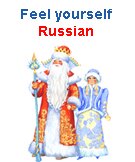|
Russian Christmas and Old Russian New Year
When Soviet Russia undertook its calendar reform in 1918, it merely moved from the Julian calendar to the Gregorian. This move resulted in a loss of 13 days, so that January 1, which was restored by the Gregorian calendar as New Year's Day, became January 14. The Russian Orthodox Church adhered however to the Julian Old Style, which is why the religious celebration of Christmas falls in Russia on January 7.
Russians, who in the majority of cases relate themselves to orthodox believers, know that much of the non-Orthodox world celebrate Christmas on December 24 and 25, so there are festivities around the city at this time as well. Many Petersburgers go to the midnight mass on the night of January 6.
Traditionally at Christmas the family would gather together to have a special meal called 'the holy supper', which begins after the first star appeared in the sky and consists of 12 courses, one for each apostle. Because Christmas celebrations were banned during the Soviet period, Russians combined some traditional Christmas customs with New Year celebrations. So, they decorate their Christmas trees on New Year, which is the greatest holiday in Russia.
On December 31 children eagerly wait for Ded Moroz (Grandfather Frost, Russian equivalent of Santa Claus) and Snegurochka (Snow maiden) to bring them gifts. Arranging a visit of Ded Moroz, who is thought to be an old pagan character, and his attractive assistant to a private home or a corporate party is a popular service here, so that, around New Year, you can sometimes spot them driving in a car or talking to children on a street.
After celebrating New Year on December 31, Russians celebrate it again (!) on the night of January 13, now as Old New Year. The latter name sounds a bit strange but fully corresponds to the Julian calendar. So, if, for some reason, you did not celebrate New Year on December 31, you are welcome to do it in Russia on January 13!
Last update: 01.01.1970
|


 Designed by — WebCom ART
Designed by — WebCom ART